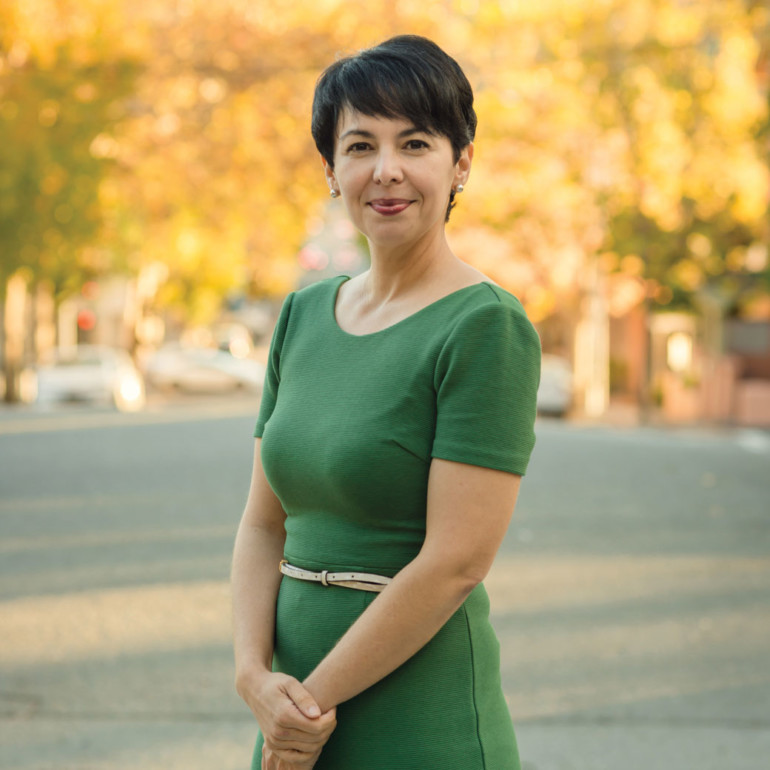
BEYOND DEALING WITH San Rafael’s merchants, residents, consumers and fellow administrators — a job that ranges from business retention to scheduling farmers’ markets — 41-year-old Danielle O’Leary has a new task: helping to implement the legalization of recreational marijuana under Proposition 64.
As Director of Economic Development and Innovation, she will help navigate the county’s largest city through a maze of recently written state requirements, regulations and restrictions regarding the legalization of pot, that mind-altering substance mired in controversy ever since its countercultural resurgence many decades ago. It will also call for O’Leary to assist San Rafael’s civic leadership in drafting its own rules and regulations regarding the growing, selling and consuming of marijuana. In Marin, 70 percent of those voting approved the California Marijuana Legalization Initiativeama in November.
Prior to joining the City of San Rafael in 2016, O’Leary held a similar economic management position with the City of Santa Rosa for eight years. During her last two years there, she implemented that city’s entry into the intricacies of legal medical marijuana. And from all reports, it was a seamless and successful transition. O’Leary, with a bachelor’s degree in entrepreneurship and nearly 20 years of municipal management experience, lives in Santa Rosa. She and her husband have two young children and are currently house-hunting in Marin.
What is the scope of Proposition 64 as it relates to California’s nearly 482 incorporated cities and 58 unincorporated county areas?
California became the largest state in the U.S. to have legalized both medical marijuana, with Prop. 215 in 1996, and now recreational cannabis with passage in November 2016 of Prop. 64. Previously, only Colorado, Washington and Oregon had legalized recreational as well as medicinal cannabis. However, at present, 29 states and the District of Columbia have some form of legalized cannabis. The details of Proposition 64 consumed 92 pages of single-spaced legislation before it was placed on the ballot. It is well thought out and designates three agencies to regulate what many project will be a $7-billion-a-year business. Basically, California’s Department of Food and Agriculture will license growers, the Department of Health will regulate manufacturing of the product, and a new agency, the Bureau of Cannabis Control, will oversee licensing of growers, delivery services and retail outlets. Since Prop. 64 passed, all three have been drafting restrictions on such subjects as the size of growing areas and the potency of the product; ways of delivering, packaging and marketing cannabis; and uniformity on where retail outlets can and can’t be located.
Does this mean the state alone will control both the medical and recreational cannabis business in California?
No, absolutely not. Every California city and county has been or is working on its own rules — within the state’s restrictions — as to how cannabis will, or will not, be sold within its individual municipal boundaries. It is doubtful any California city or county will disallow the sale of marijuana; the economic enticements are too tempting. Yet you never know: some counties in the south still don’t allow the sale of alcohol. As far as the Bay Area goes, only Santa Cruz County and the cities of Berkeley and Oakland appeared ready to begin the sale of recreational marijuana to adults on, or soon after, January 1st.
At present, where does the City of San Rafael seem headed?
In 1996, when Proposition 215, the Compassionate Use Act, authorized the sale of medical marijuana, San Rafael adopted a policy, and now we are basically refining and updating. San Rafael, like the County of Marin, seems headed to licensing delivery services of medical marijuana only, and that requires a doctor’s recommendation or a state-issued Medical Cannabis Card that says a patient must use cannabis as a way of mitigating the effects of an ailment or ailments. It has still not been determined where in San Rafael those delivery services will be allowed to locate; yet as recent state regulation stipulate, there will be no deliveries by drones, bikes or driverless vehicles, only human-controlled cars and trucks. And no, there is no talk whatsoever of shops on Fourth Avenue selling pot.
How do you see it all playing out?
Well, there are still many unknowns. The amount of acreage in which growers will be allowed to propagate marijuana is still not clearly defined. Presently, there are approximately 7,000 acres in production in California, most of them in Mendocino, Humboldt and Trinity counties, with many in Sonoma County, working fewer than five acres of land where the result is primarily craft cannabis, much like we now have craft beers, chocolates and cheeses. With larger or even unlimited acreage, there’s a fear that future growers could be like tobacco corporations where the quality of product could suffer. Also, the manner in which marijuana is consumed is likely to be heavily regulated and restricted. For this, many municipalities are modeling their marijuana laws after their existing smoking ordinances. In other words, you can’t smoke marijuana in bars or restaurants just like you can’t smoke cigarettes or cigars in these spaces. Also, Prop. 64 disallows ingesting cannabis in public, and of course [stipulates] not while driving. In fact, Proposition 64 stipulated that $15 million of state excise tax on growing and selling of cannabis will go to the California Highway Patrol to find a protocol for determining if a driver is impaired because of ingesting marijuana.
What, if any, is your personal connection to cannabis?
Before taking my job with the City of San Rafael, I was the caregiver for my father-in-law as he experienced an extensive and painful period of illnesses involving non-Hodgkin’s lymphoma, multiple sclerosis and cancer. At first the doctors prescribed heavy medications, some of them opioids. However, they not only didn’t ease the pain, they seemed to make him groggy, even depressed. We gave it considerable thought before turning to medical marijuana, and it was intriguing for us to learn how different strains of cannabis perform different medical roles. There are forms of cannabis that don’t have a psychoactive effect, just pain management. My father-in-law eventually passed away, but I am witness to the fact cannabis made the last months of his life at least bearable. He regained much of his appetite, his pain diminished significantly and he was definitely more mobile. As to my husband and I using recreational cannabis, the answer is no.
To date, what are your firsthand impressions of the legalization of cannabis?
The immense thoughtfulness and level of scrutiny that this product and business are going through are unlike anything I’ve ever experienced, and it surprises people. I’m lucky I had those two years in Santa Rosa and watched its cannabis economy evolve. And I realize every community has to go at its own pace in coming up with a cannabis program that works for it. This is a rare moment in time; this is a movement, and it’s coming. My job is never dull because there are a lot of unknowns. All the different lenses to look through: social justice, economics, enforcement and public safety. Overall, I think we are going to be OK as long as we keep adapting and evolving.


